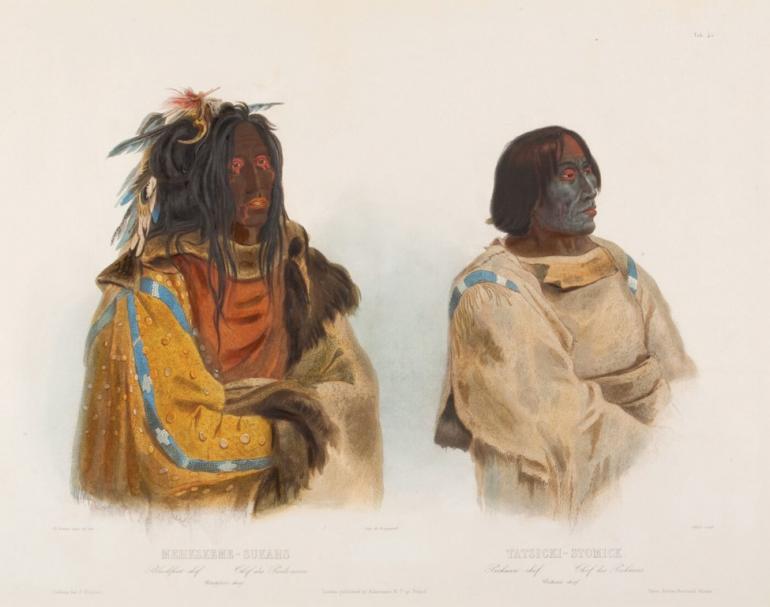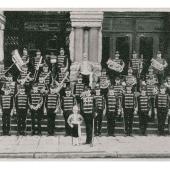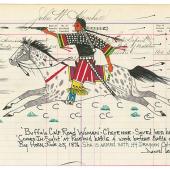From Lewis and Clark to Fort Piegan: The 25-Year-Long War between Mountain Men and the Piikáni (Piegan) Blackfeet

When the Corps of Discovery traversed the Great Plains of Montana in 1805 and 1806, they encountered a landscape that utterly teemed with wildlife. Indeed, Lewis and Clark proclaimed that the headwaters of the Missouri were “richer in beaver and otter than any country on earth.” Reports of those findings reached the receptive ears of traders traveling upriver even before Lewis and Clark returned to St. Louis on September 23, 1806.
Prior to the onset of winter in 1807, three trading posts were constructed near the western and southern borders of Piikáni (Piegan) country. Establishment of trapping operations in their territory and trade with the Flathead and Crows, both of whom were tribal enemies, aroused Nitsitapii (Blackfeet) and Gros Ventre opposition, which quickly escalated into a sustained pattern of conflict with American trappers. Between the summer of 1808 and autumn of 1810, Blackfoot war parties systematically decimated expeditions led, respectively, by John McClellan and Charles Courtin. In 1810, the Missouri Fur Company, which focused its efforts on the Three Forks of the Missouri, also suffered catastrophic losses. By that fall, 20 members of their 32-man contingent had fallen in battle.
A decade-long hiatus in trapping activity followed Blackfoot and Gros Ventre expulsion of this first wave of interlopers. The duration of this period is attributable primarily to the financial impact of the War of 1812, but Nitsitapii military might most certainly made an indelible impression on subsequent traders, trappers, and explorers, who steered far to the south of Blackfoot lands. The magnitude of this closure, however, is summarized by historian Keith Algier, who observed that the outbreak of war with Great Britain was followed by “eight years during which no beaver pelts from Crow country were received in St. Louis.” Therefore, one can reasonably conclude that “few, if any, Americans were in Crow [or Blackfoot territories] during these years.”
By the early 1820s, improved economic conditions spurred renewed interest to expand the American fur trade into the upper Missouri. Predictably, the onset of trapping operations in 1823 triggered another cycle of bloodshed. On or about May 30, several hundred Kainai (Blood) warriors attacked a party of 29 MFC trappers on the Yellowstone. Seven Americans, including expedition leaders Michael Jones and Robert Immel, were killed in action.

Mehkskeme, Blackfoot-Chief. Tatsicki-Stomick/
Piëkann Chief by Karl Bodmer, 1833.
Andrew Henry, a founder of the Rocky Mountain Fur Company, led a party of trappers to the Great Falls of the Missouri. An engagement with Piikánis, fought in April 1823, resulted in the deaths of four trappers. The Ashley-Henry expedition suffered a more devastating defeat on the morning of June 2, when they were ambushed by Arikara warriors from the palisades of their village. In the brief skirmish that ensued, 13 of Ashley’s men succumbed to musket fire, and 11 more were wounded. Collectively, these events convinced Ashley and Henry to abandon the upper Missouri as a supply line and adopt the overland route and logistical system that became hallmarks of the rendezvous period (1825-1840).
How many mountain men forfeited their lives to the Blackfeet and/or their Gros Ventre allies? Data on this topic is incomplete, especially when independent trappers are factored into the equation. Nevertheless, Hiram Martin Chittenden, a pioneering researcher in this field, discovered that the Rocky Mountain Fur Company incurred 70 fatalities “from 1822 to 1829 inclusive.” That total, according to Chittenden, certainly would approach one hundred if trappers who lost their lives during the company’s last operational years were taken into consideration. Those figures are corroborated by the work of historian David Wishart. From July 1826 until late December 1829, “Smith, Jackson, and Sublette lost forty-one men to the Indians, which amounted to one-third of the company’s average employment. More than three-quarters of the fatalities occurred in the disastrous 1827-8 season.”
In August 1829, the RMFC’s management partners concluded that Piikáni territory then comprised the only untapped operational theatre. The “Blackfoot brigades” that they subsequently dispatched to this fiercely contested zone averaged 70 men, a force large enough to discourage pitched battles. However, competition over access to this region increased when the American Fur Company formally entered the fray in 1830. George Catlin learned, in 1832, that the AFC lost “some fifteen or twenty men annually, who fall by the hands of [the Blackfeet] people.” In a communique to General William Clark, dated July 26, 1833, Indian Agent John F. A. Sanford concluded similarly that “The Blackfeet have Killed only 18 or 20 the last winter.… This does not surprise me at all, – as long as Whites are trapping in their Country it will be the case.”
Despite ongoing hostilities, three events during the 1820s clearly indicate that Piikánis had begun to entertain the prospect of commerce with Americans. Their previously staunch opposition was blunted by the forced merger of the Hudson’s Bay Company and Montreal-based North West Company in 1821, which stripped the Blackfeet and other First Nations of the leverage they had exercised in negotiations with Canadian traders on the North Saskatchewan River.
A Piikáni headman named Mi’ksskimmisoka’simi, or Iron Shirt, made the first Blackfoot peace overture on May 18, 1823. While visiting the encampment of trappers employed by the Missouri Fur Company, Iron Shirt invited them to build a trading post at the mouth of the Marias River. The significance of this event unfortunately was ignored in the aftermath of the Kainai attack on Immel and Jones’s party, which occurred only 12 days later.
In 1827, a short-lived peace accord between the Blackfeet and Flathead provided the opportunity for Kainai and Piikáni leaders to meet American trappers in Flathead territory. Once again, the Blackfeet extended an invitation to “establish a branch post in their country,” but renewed intertribal hostilities soon prevented further access to trappers who plied beaver streams west of the Continental Divide.
When peace was finally brokered and commercial ties forged between the Piikáni and American fur traders, it was achieved through the entrepreneurial vision of Kenneth McKenzie and the diplomatic efforts of Jacques Berger, a man whom Chittenden described as more eminently qualified for this particular mission than anyone McKenzie could have found “in the entire west.” A 21-year veteran of the Canadian fur trade, Berger retained sufficient mastery of the Blackfoot language to serve competently as an envoy in preliminary negotiations. He also knew that the Blackfeet had become more receptive to the notion of trade with Americans. Berger attended the 1827 meeting in which Kainais and Piikánis invited mountaineers employed by Smith, Jackson, and Sublette to build a trading post on their land. His ability to personally corroborate the attitudinal shift expressed in those conversations gave McKenzie legitimate hope that a breakthrough in relations with the Piikánis was a realistic possibility.

In late autumn of 1830, Berger and a party of five men left Fort Union and traveled by dogsled into Blackfoot country. They eventually made contact with a Piikáni band led by Aáhsa’paakii (Good Woman), who recognized Berger from his previous visits as a trader for the North West Company. After wintering at Good Woman’s village, Berger led a delegation consisting of representatives for all three Nitsitapii tribes back to Fort Union in the spring of 1831. Negotiations there culminated in agreement, for the first time, to establish an American trading post in Piikáni territory. That fall, construction of Fort Piegan near the confluence of the Missouri and Marias rivers formally signified the end of the Blackfoot blockade to the upper Missouri fur trade.
Unlike their American predecessors, McKenzie and Berger established trade with the Piikáni by adhering to the time-tested Canadian business model. Quite simply, they proposed and engaged in a mutually beneficial exchange of goods.
Nevertheless, the AFC and the Rocky Mountain Fur Company continued to dispatch brigades of trappers into Blackfoot country as beaver populations became depleted elsewhere. Indeed, a journal entry recorded at Fort Union on May 5, 1835, acknowledged that “the beaver trade for the last three years has been regularly declining, [so it] appears that our sheet anchor will be Robe trade.” The introduction of steamboats to the upper Missouri in 1832, and their ability to transport massive cargoes, enabled the AFC to pivot adroitly in response to changes in market demand and resource availability. Records from Fort McKenzie, their principal Piikáni post from 1834-1844, illustrate the speed with which that transition occurred. Traffic in bison robes from this hub increased from approximately 3,000 in 1835 to 21,000 in 1841.
Members of the Blackfoot brigades, however, experienced no cessation of hostilities during the final years of the mountain man era. Although his remarks may exaggerate the frequency with which military engagements occurred, Kit Carson opined that, by 1834, “a trapper could hardly go a mile without being fired upon.” Despite such danger, some mountain men stubbornly persisted in their quest for plews until the end of the rendezvous period. As Carson defiantly observed, “We determined to trap wherever we pleased, even if we had to fight for the right.”












- Reply
Permalink